
cocoaPTT 2.0
Kok Chen, W7AY [w7ay (at)
arrl (dot) net]
Last updated: November 5, 2008
Introduction
cocoaPTT 2.0 is an AppleScriptable application to provide
push-to-transmit (PTT) capability to applications that
don't natively support the PTT function. In addition to the
AppleScript path, the application also provides a small
control panel interface to directly key the PTT line on or
off.
cocoaPTT 2.0 is built as a Universal Binary application and
works natively with both PowerPC and Intel based
Macintoshes. You can download cocoaPTT 2.0 here.
The original cocoaPTT application controlled PTT through
the Request To Send (RTS) or the Data
Terminal Ready (DTR) pin of a
serial port. In addition to the RTS/DTR serial control
lines, cocoaPTT 2.0 now supports PTT through the ÁH Router,
the MacLoggerDX PTT scripts, and a user defined set of
AppleScripts to handle other PTT situations.
cocoaPTT 2.0 is not a supported program. For non-commercial
use, the Xcode project and sources are available at the
download page.
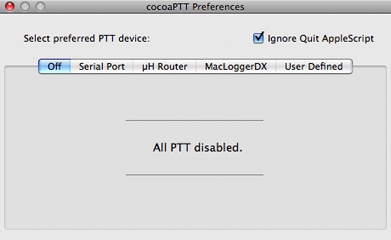
Configuration
Before calling cocoaPTT 2.0 from another application, you
will need to configure the interface. First make sure that
any PTT device that you might use (microKeyer, serial port,
etc) are connected before launching cocoaPTT.
Select the Preferences... menu item in the cocoaPTT menu in
the Menu Bar (or use the Command-comma keyboard shortcut)
to bring up the Preference panel.
The preferences panel contains a tab view. You use the tab
view to select which PTT device to use.
When Off is selected,
cocoaPTT will accept AppleScripts normally, but it will not
perform any PTT activity.
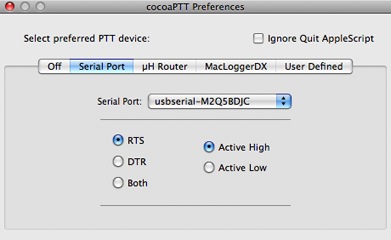
When Serial Port is
selected, you are presented with an interface that is
similar to the original cocoaPTT.
The popup menu has a list of available serial ports. If you
don’t see the port you need, double check that your
serial port is connected to the ISB bus. Then select the
Off tab and the Serial Port tab again to
make cocoaPTT rescan for devices.
If you still don;t see the device, you can try to look for
it in the System Profiler (an application that is in the
MacOS Utilities folder). If you cannot find a serial port
port in the System Profiler, cocoaPTT will not be able to
find it either. Please be aware that most USB serial port
adapters will require a manufacturer supplied driver that
works in the version of Mac OS X that you are running.
The above figure the preference panel after a Keyspan USB
PDA adapter (KeySerial1) is selected.
In addition to choosing which
serial port to use, you can also choose whether to use the
RTS or the DTR pin of the port. You can also choose whether
the polarity of the RS-232 signal is high (positive voltage
at the serial port pin) to key PTT, or low (negative
voltage at the serial port pin) to key the PTT line of the
transceiver. The choice of polarity depends on how
you’ve designed your interface and what the
transceiver needs.
There is a third choice under RTS and DTR. This allows you
to key both RTS and DTR at the same time. You can use this
selection if you are not sure if RTS or DTR is the signal
that is being used and both signals are not being used by
other applications, or if the PTT device has wired-ORed the
hardware RTS and DTR signals, as with the RIGblaster nomic.
Please note that different drivers / serial ports will
launch to either active or inactive states (and might cause
your transceiver to key before cocoaPTT is launched). There
is not much you can do about that except to invert the
logic state before the keying signal to the transceiver.
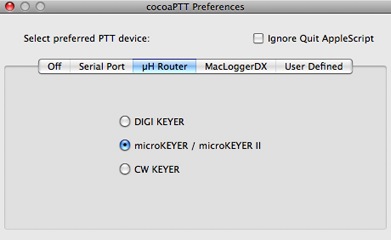
When the ÁH Router tab
is selected, cocoaPTT 2.0 will launch the ÁH Router application to perform PTT
on the microHAM keyers. As seen in the above figure, you
can select the DIGI KEYER, the microKeyer (original or
version II) or the CW keyer. Please note that the
microHAM USB Interface II is a simple serial
port device; you should use the Serial Port tab
instead of the ÁH Router tab to control the USB
Interface II.
If you select MacLoggerDX tab, cocoaPTT will send
AppleScripts to the MacLoggerDX application to perform
PTT.
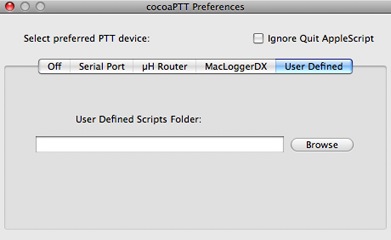
The User Defined tab,
shown above, behaves in the same way as the User Defined PTT mechanism in
cocoaModem. This allows you to execute custom scripts to
command other applications (such as TS2K) to perform PTT.
The User Defined PTT tab allows you to place three script
files, called pttKey.scpt, pttUnkey.scpt and
pttQuit.scpt
in a folder. The last script file is not mandatory and can
be absent. When you send cocoaPTT a key or unkey
AppleScript, cocoaPTT will run the script files that are in
the designated folder.
Notice that the preference panel includes a checkbox called
"Ignore Quit AppleScript." This checkbox allows you to set
cocoaPTT to ignore any "Quit" AppleScript message. It can
be useful when there are more than one application using
cocoaPTT and not all of them have set the connection count
(see AppleScript Interface below).
Control Panel
When in the idle state, the cocoaPTT control panel looks
like the following.

Click on the Key button to
activate PTT. The interface turns into the following. Click
on the Unkey button to get back to the idle state.

This panel can be closed (use
the red button at the left of the panel’s title bar)
if you don’t need to look at it -- for example when
you are controlling cocoaPTT through a separate application
using the AppleScript interface.
To reopen the control panel, make the cocoaPTT app active
and then select the Show PTT Control Panel menu
item in the Window menu in cocoaPTT’s menu bar.
You can also reopen the control panel by selecting the
Show PTT Control Panel menu item that is displayed
when you hold down the mouse button over the cocoaPTT item
in the Dock (see figure below):
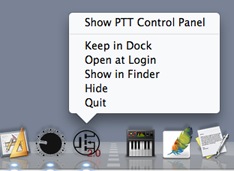
The serial port and RTS/DTR
selections and the control panel position are saved to a
property list file called w7ay.cocoaPTT.plist in
your user Preferences folder when you quit cocoaPTT.
AppleScript Interface
cocoaPTT can be controlled through AppleScript. The
following is a script to activate PTT on the currently
selected device (the selected tab view in the Preferences
panel). This is the same script as the one in the old
cocoPTT.
The following is a script to deactivate PTT.
In addition, you can control individual devices directly. This will bypass the control panel (i.e., the control panel will not show the correct PTT state). An example is
The above will key the PTT on the serial port. Setting the pttState to 0 will unkey the PTT line on the serial port. The other devices are addressed by using routerPTT, mldxPTT and userDefinedPTT.
This allows multiple applications to share cocoaPTT 2.0. To prevent an application from causing cocoaPTT to quit while another application is still using it, you can use the following script to keep a "retain count" for your application:
Each connect message will increase the connection count in cocoaPTT by 1. As long as the connection count is non-zero, cocoaPTT will not quit through AppleScript.
When your application has finished using cocoaPTT, you should send a disconnect message to reduce the connection count by 1:
Both connect and disconnect returns an integer of the updated connection count.
Finally, you can send a quit message:
This will cause cocoaPTT to quit if there are no longer any active connections. The script returns the number of active connections. If a zero is returned, cocoaPTT would quit within 2 seconds upon receiving the quit message.